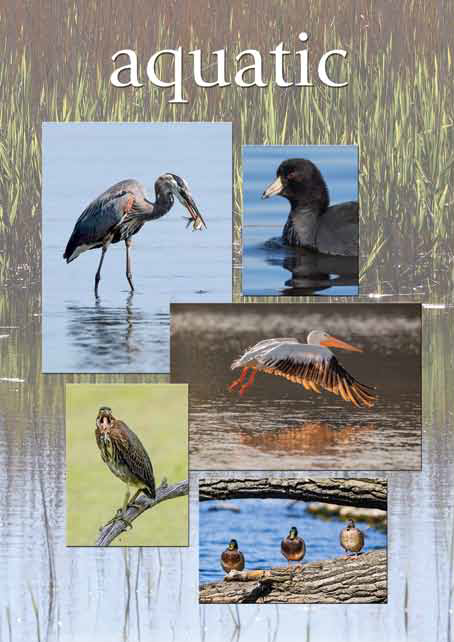Birding is a great year-round activity for everyone—from solo hikers to families introducing youngsters to the great outdoors.
What birds will I see when I'm birding?
More than 450 species of birds have been sighted in Illinois, with just over 200 species documented as nesting in the state. Most of the other species are migrants, flying north through Illinois each spring to their nesting grounds, and passing through again each fall on their way to warm wintering grounds. According to eBird.org records, 219 species of birds have been sighted at the Garden.
How do I start birding?
A great place to start birding is the viewing station inside the Nature Center. Multiple bird feeders attract a variety of species to the window, and an indoor bench allows people to sit and watch the action while working out an identification. Wild Birds Unlimited generously donates seed all year for the various feeders.
New to the viewing station is a Lumatron Nature’s Window sound monitor, which allows visitors to hear birds at the feeders.
Contributions from participants in the 2022 LMG 8K trail race funded the sound monitor, and donations from the 2023 trail race are earmarked for the purchase of a spotting scope.
Annual Bird Hikes
Another excellent way to jump-start, or improve, birding knowledge is to participate in the Garden’s annual bird hikes lead by local birder Kevin Veara. Hikes typically occur in the spring and fall during the peaks of migration.
In 2023, hikes occured on on April 15, 22, and 29 and May 6, 13, and 20.
Bird Sampler
Here are a few of the birds you may see on your visits to the Garden, photographed by talented Garden visitors and volunteers.
 Photos by Cindy Harris
Photos by Cindy HarrisBirds of the Woodland (clockwise from top left)
Full-time residents of cities and woodlands, male and female northern cardinals sing “cheer, cheer, cheer” or “birdie, birdie, birdie” throughout most of the year. Photo by Cindy Harris. Two woodpecker species, the showy red-bellied woodpecker and subdued black-and-white downy woodpecker, provide an opportunity for viewers to recognize quick identification points, including size, color, and pattern. Photo by Cindy Harris.
A raspy “mew” sound from the dense thickets and shrubby edges of a trail most likely is a gray catbird. Look for its black cap and a rusty patch under its tail. Photo by Anne Scrivner.
A bright-red head, black-and-white body, and chisel-like bill are key to identifying a red-headed woodpecker. Photo by Cindy Harris.
Blue jays make a variety of calls, but their raucous “jay, jay” call is one of the first bird calls many people learn. Photo by Cindy Harris.
Birds of the Prairie (clockwise from top left)
Male eastern bluebirds possess a brilliant royal blue back with red-brown on their breast. Females are not as vivid in color. Photo by Anne Scrivner.
Metallic blue-green tree swallows perch on nest boxes at Lincoln Memorial Garden, pausing after cruising over the prairie in their hunt for flying insects. Photo by Janet Pieper.
The brown thrasher is reddish-brown bird with a heavily streaked breast and a mastery of complex songs, often copying the songs of other species of bird. Photo by Matthew Ketter.
Listen for the “conk-a-ree” of the red-winged blackbird. Much less showy than their mates, females are heavily streaked, helping them to remain unseen on their nests. Photo by Anne Scrivner.
“Wichety-wichety-wichety” calls the common yellowthroat from perches in thickets and fields. True to its name, this bird has a yellow throat, with the male having a black mask topped with a white stripe.
 Photo by Anne Scrivner
Photo by Anne Scrivner
 Photos by Cindy Harris & Philip Wheat
Photos by Cindy Harris & Philip WheatBirds of Aquatic Habitats (clockwise from top left)
The largest of the herons found in Illinois, the great blue heron hunts for fish along the shoreline of Lake Springfield. Photo by Cindy Harris.
The gray body, stark red eye, and white bill help in identifying the American coot. Its body is said to have a chicken-like shape. Photo by Cindy Harris.
Working as a group, white pelicans hunt for fish, scooping up their catch in a bill that can hold three gallons of water. Photo by Philip Wheat.
The iridescent, green-headed male mallard, and his mottledbrown mate, are common residents on lakes, ponds and rivers. Photo by Cindy Harris.
Perhaps because it is one of the smallest members of the heron family found in Illinois, one green heron presented a sassy attitude to the photographer. Photo by Cindy Harris.
Help grow the Lincoln Memorial Garden eBird list. Register with eBird and add your Garden
sightings to the list!
Download Birds of the Garden